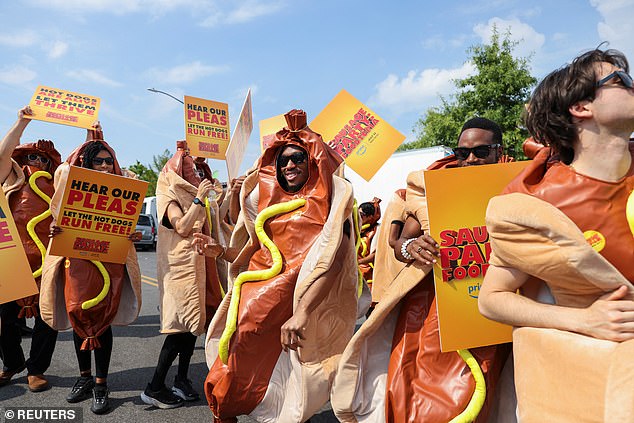The Grim Reality of What REALLY Happens to the Bodies of Nathan’s Hot Dog Eating Contestants — and the Insane Training to Prepare for It
Another Fourth of July means another round of Nathan’s Famous Hot Dog Eating Contest, but few people realize the physical strain it takes on the bodies of its contestants.
Patrick Bertoletti won the title on Thursday after eating 58 hot dogs and buns in 10 minutes during the event at Coney Island in Brooklyn, New York.
That is equivalent to more than 15,000 calories and quadruples the recommended daily amount of salt and fat for an adult in one go.
In the women’s event, Miki Sudo won her 10th title. She ate 51 hot dogs and buns, setting a new world record for women.
Research shows that eating dozens of hot dogs at once can cause the stomach to expand up to four times its normal size, turning it into “a huge, distended, food-filled sack that takes up most of the upper abdomen.”
Patrick Bertoletti won the title Thursday after eating 58 hot dogs and buns in 10 minutes during the event at Coney Island in Brooklyn, New York

In the women’s category, Miki Sudo won her 10th title, consuming 51 hot dogs and buns
Experts warn that over time this can lead to the body no longer being able to process solid food, causing competitive eaters to suffer from persistent nausea and vomiting.
The true health effects of competitive eating are not well known because it is a new phenomenon and it would be unethical to study it in the general public.
Competitive eaters also spend months stretching their stomachs using ‘dangerous’ techniques such as ‘water loading’, or gulping down gallons of milk and eating mountains of cabbage and high-fiber foods.
According to the nutritional information on Nathan’s websiteone of the original Coney Island hot dogs with natural casing, contains 170 calories, 16 grams of fat (6 grams of which are saturated fat), and 480 milligrams of sodium.
This means that the male winner, Bertoletti, ate 9,860 calories in 10 minutes, excluding the sandwich.
Each sandwich contains 130 calories, which equates to 17,400 calories, which is twice the amount of calories the CDC recommends for an adult male to consume per week.
High sodium intake is enough to raise blood pressure, which can cause a heart attack or stroke. The recommended sodium level is no more than 2,300 milligrams per day, just under five hot dogs.
And the high fat content can lead to nausea, diarrhea and gastrointestinal upset, said Academy of Nutrition and Dietetics spokeswoman Debbie Petitpain CBS News.
However, experts said that as long as these participants return to eating normally, their bodies should function normally again.
Legendary hot dog eater Joey “Jaws” Chestnut, who has won the contest 16 times, says he trains for three months before each Nathan’s contest, doing oral exercises to strengthen his mouth and throat.
“I record every workout and then try to take it a step further and figure out what I can do differently,” Chestnut said in 2021.

WHO LET THE DOGS OUT: People wore hot dog costumes in a parking lot in Coney Island, NYC
“You can only practice so much. If I practice too much, I start gaining weight, and if I gain weight, I start eating slower. So it’s a strange double-edged sword. You have to love food, but you can’t eat so much that it becomes unhealthy.”
The first Nathan’s hot dog eating contest, held in 1972, was won by Jason Schechter, who ate only 14 sausages.
While it’s unclear why the amount eaten has changed over the decades, it’s likely because people spent months exercising to expand their stomachs.
A 2007 study from the University of Pennsylvania analyzed a 29-year-old man who ranked in the top 10 in the world in competitive eating.
The man was asked to ingest an effervescent agent and high-density barium, after which he was allowed to eat hot dogs for 12 minutes. This allowed the researchers to see how the food moved through his body.
Another group, who ate regularly, ate seven francs before they developed symptoms.
The study found that the competitive eater’s stomach could expand as he ate the food.
“The key to success in competitive speed eating is the ability to slowly train and adapt the stomach to expand and dilate remarkably, allowing the fast eater to consume an extraordinary amount of food in an extremely short period of time (possibly on top of a naturally compliant stomach),” according to the published article.
The team compared a competitive eater to “a predatory carnivore that regularly gorges on its prey, consuming enormous amounts of food to stay alive until it catches another prey days or even weeks later.”
However, these eaters may also lose the feeling of fullness and satiety they experience when eating regularly.
The researchers noted that there isn’t enough data to predict what will happen to competitive eaters.
The team wrote in the study that there is a potential risk that the dilated, flaccid stomach will eventually decompensate and turn into a giant sac that can no longer shrink to its original size and can no longer drain solid food.
